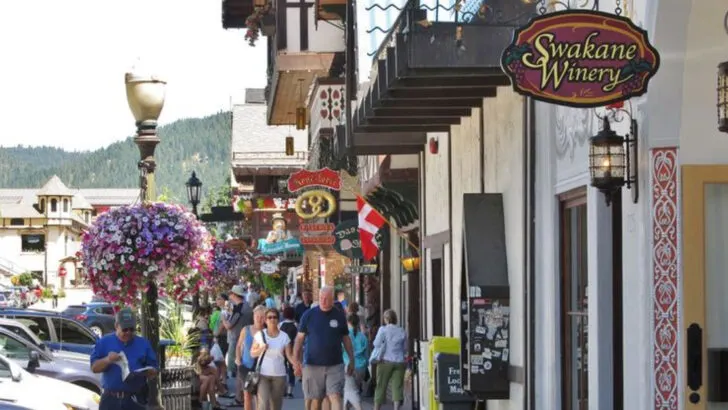The Pacific Northwest has always danced to its own rhythm—misty, mysterious, and beautifully stubborn. But lately, something’s changed. The coffee is stronger, the Wi-Fi is faster, and strangers with laptops have started claiming the best window seats. Locals call them remote workers. Some call them saviors. Others aren’t so sure. In these tiny coastal and mountain villages, quiet charm has collided with tech-age ambition. Rents have doubled. Breweries are booming. And the same people who fled the city for peace are now fighting to keep it.
From Oregon’s fog-drenched coast to Washington’s forested lakes, these 12 villages are caught in a love-hate story with progress—and nobody can agree who’s winning.
Leavenworth, Washington
In the heart of the Cascades, Leavenworth offers a picturesque setting that draws remote workers seeking both beauty and tranquility. Its Bavarian charm is irresistible, inviting new residents to enjoy its unique culture.
However, the influx has led to crowded streets, making it difficult for locals to find the peace they once cherished. Housing prices have soared, prompting debates on sustainable growth.
While many businesses thrive, some fear losing the village’s authentic essence. The question remains: can Leavenworth balance growth with its cherished traditions?
Bainbridge Island, Washington
A short ferry ride from Seattle, Bainbridge Island is a serene escape for remote workers craving proximity to the city without the hustle. The island’s natural beauty is a major draw, offering idyllic views and trails.
Yet, this tranquility faces challenges as the population swells. The increased demand for housing strains local resources and infrastructure.
Despite these issues, many embrace the fresh energy and innovation remote workers bring. Whether this shift enhances or erodes Bainbridge Island’s character is a topic of lively debate.
Astoria, Oregon
Astoria’s rich maritime history and scenic waterfront make it a magnet for remote professionals eager for inspiration. The town’s creative spirit thrives with an influx of new ideas.
However, the blend of old and new creates tension. Longtime residents worry about gentrification and the loss of affordability.
This artistic haven balances nostalgia with progress, sparking conversations about inclusivity and preservation. Will Astoria maintain its historic charm amid these changes?
Port Townsend, Washington
Known for its Victorian architecture and maritime culture, Port Townsend attracts remote workers who value creativity. Its vibrant arts scene and festivals thrive with new participants.
Yet, the surge of newcomers challenges the local housing market and infrastructure. Concerns about preserving the town’s unique heritage emerge.
Residents appreciate the economic boost but seek ways to maintain balance. The town’s future rests on bridging tradition with innovation in harmony.
Hood River, Oregon
Hood River, famed for windsurfing and breathtaking landscapes, lures remote workers with its adventurous lifestyle. The fusion of outdoor activities and work-from-home flexibility appeals to many.
Yet, the growing population tests the town’s capacity for sustainable living. Increasing property values and cost of living raise concerns.
Locals enjoy the economic vitality but debate the long-term effects on Hood River’s identity. Can this outdoor paradise sustain its allure?
Cannon Beach, Oregon
Cannon Beach’s iconic Haystack Rock and stunning sunsets create a magnetic pull for remote workers seeking inspiration. The tranquil environment fuels creativity and productivity.
However, this influx strains the small community’s resources and raises housing affordability issues.
As businesses benefit from new clientele, locals ponder the essence of their coastal haven. Will Cannon Beach adapt without sacrificing what makes it special?
Friday Harbor, Washington
Friday Harbor, nestled in the San Juan Islands, enchants remote workers with scenic views and a tight-knit community. This picturesque haven offers a perfect blend of work and leisure.
Yet, the isolation that once defined it now faces the challenge of accommodating newcomers. Infrastructure and cost of living become critical talking points.
While some welcome the fresh perspectives, preserving the island’s intimate feel remains a priority. Can Friday Harbor evolve while maintaining its charm?
Twisp, Washington
Twisp, with its rustic allure and artistic vibe, invites remote workers to join its creative community. The town’s support for local art flourishes with new energy.
However, the rise in population puts pressure on local amenities and housing. Concerns about maintaining affordability and community spirit arise.
Residents cherish the economic growth but emphasize careful planning to retain Twisp’s unique character. Will this artistic enclave manage the balance?
Coupeville, Washington
On Whidbey Island, Coupeville’s historic waterfront and scenic landscapes captivate remote workers seeking peace. The village’s charm lies in its simplicity and natural beauty.
Yet, the influx of new residents prompts discussions on resource allocation and preserving heritage. Housing becomes a central issue.
The community values progress while honoring its roots. How can Coupeville navigate change without losing its essence?
Yachats, Oregon
Yachats, known as the “Gem of the Oregon Coast,” attracts remote workers with its rugged beauty. The town offers a serene escape for those seeking solitude.
Yet, the community faces housing and infrastructure challenges as new residents arrive. Balancing growth and conservation becomes crucial.
Locals enjoy the renewed vibrancy but remain cautious about the future. Will Yachats keep its natural splendor intact?
Langley, Washington
Langley’s quaint streets and artistic flair lure remote workers looking for inspiration. The town’s creative culture thrives with new ideas and collaborations.
Yet, the growing demand challenges housing availability and affordability. Locals engage in discussions on sustainable expansion.
While many enjoy the renewed energy, preserving Langley’s artistic legacy is vital. Can this artistic hub grow without losing its soul?
Sequim, Washington
Sequim, famous for its lavender fields and sunny climate, attracts remote workers seeking a peaceful lifestyle. The town offers a refreshing blend of nature and tranquility.
However, the rise in popularity brings concerns about infrastructure and housing demands. Balancing growth and community values becomes essential.
Residents appreciate the economic boost but focus on maintaining Sequim’s serene environment. Will this sunny haven flourish harmoniously?

